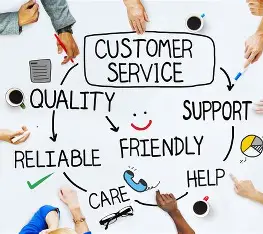Table of Contents
Introduction
In today’s hyper-competitive business environment, companies are fighting not only for customer acquisition but also for customer retention. The modern consumer is empowered, informed, and has countless options at their fingertips. Amidst all this noise, customer service stands out as a primary factor influencing brand loyalty.
Gone are the days when quality and price were the only parameters defining customer choice. Now, how a brand treats its customers before, during, and after the purchase can make or break its image. Customer service is no longer just a department — it’s a brand strategy.
What is Brand Loyalty?
Brand loyalty refers to the emotional connection and consistent preference a consumer shows towards a brand over its competitors. Loyal customers don’t just make repeat purchases; they become brand advocates, defend the brand, and drive referrals.
But how is this loyalty earned?
Not just through good products. It’s created through positive experiences, empathetic engagement, and a sense of being valued. And this is where customer service plays a monumental role.
How Customer Service Plays A Role In Long-Term Brand Building
The Direct Link Between Customer Service and Brand Loyalty
1. Customer Experience is the New Marketing
Today, your customer service is your first impression, and often the lasting memory. A study by PwC found that 73% of customers point to customer experience as an important factor in their purchasing decisions.
A smooth, respectful, and empathetic interaction builds trust. In contrast, a frustrating experience — even once — can lead to lost customers, negative reviews, and brand damage.
2. Customer Service Builds Trust
When issues arise, how you respond becomes a reflection of your brand’s values. A fast, respectful resolution says, “We care.” Trust built in such moments fosters long-term loyalty.
Brands like Zappos, known for their exceptional service, have become case studies in turning customer service into brand loyalty and even free publicity.
Key Elements of Excellent Customer Service That Drive Loyalty
1. Responsiveness
Timely responses show customers they are a priority. Whether through email, phone, or social media, fast replies reduce frustration and enhance satisfaction.
2. Personalization
Generic scripts no longer work. Customers want to feel like real people are talking to them — who understand their history, preferences, and needs.
3. Empathy
Training service teams to listen, understand, and acknowledge customer feelings can de-escalate issues and build an emotional connection.
4. Consistency Across Channels
Whether someone contacts you via Instagram, email, or phone — the experience must feel seamless and unified. Omnichannel support is essential.
5. Proactive Support
Reaching out to check on product delivery, usage issues, or offering help even before customers ask shows initiative and builds goodwill.

Real-World Examples of Customer Service Leading to Loyalty
🔹 Amazon
With their “customer-obsessed” philosophy, Amazon makes returns easy, offers quick refunds, and has 24/7 support. This convenience and care keep customers coming back.
🔹 Apple
Apple’s Genius Bar and after-sales support are known for their high-quality experience. They don’t just fix devices; they offer empathy and education.
🔹 Starbucks
Starbucks is known for treating its customers like guests. Baristas remember names, preferences, and create a community atmosphere — leading to brand loyalty.
🔹 JetBlue
JetBlue has turned countless bad travel experiences into happy ones with quick customer support responses, compensation, and thoughtful gestures.
How Bad Customer Service Damages Brand Loyalty
One bad experience can cause a ripple effect. According to Zendesk:
- 61% of customers will switch to a competitor after just one bad experience
- 95% will tell others about their poor experience
- It takes 12 positive experiences to make up for one negative one
In the digital age, this backlash is often public — through tweets, reviews, or YouTube videos.
Role of Social Media in Customer Service & Brand Loyalty
Social media is now a front-line customer service platform. People tag brands, leave comments, or post grievances publicly. How a brand responds (or doesn’t) affects perception:
- Fast replies boost satisfaction
- Empathetic public responses show accountability
- Ignoring customers can appear careless or arrogant
Brands like Spotify, Netflix, and Nike have nailed the tone and responsiveness, often adding humor and personality, turning customers into fans.

The ROI of Good Customer Service
Investing in customer service pays off in several ways:
- Customer Retention: Acquiring new customers is 5–7 times more expensive than retaining existing ones.
- Increased CLV (Customer Lifetime Value): Loyal customers spend more over time.
- Word-of-Mouth: Happy customers become vocal advocates.
- Reduced Churn: Customers forgive mistakes more easily when they feel valued.
📊 Customer Service & Brand Loyalty: Key Elements Table
| Customer Service Element | Impact on Brand Loyalty | Real-World Example |
|---|---|---|
| Responsiveness | Builds trust and reduces customer frustration | Amazon’s 24/7 support |
| Empathy & Personalization | Makes customers feel valued; strengthens emotional connection | Zappos’ customer-first policies |
| Problem Resolution Speed | Encourages repeat business; reduces churn | Apple’s in-store Genius Bar |
| Omnichannel Support | Allows seamless service across platforms (chat, phone, email, etc.) | Nike’s unified digital support |
| Proactive Support | Anticipates needs, creating customer delight | Netflix recommending fixes before complaints |
| Empowered Employees | Faster decision-making and resolution leads to greater satisfaction | Ritz-Carlton giving staff spending authority for guest recovery |
| Feedback Handling | Helps customers feel heard and fosters brand improvement | Starbucks’ “My Starbucks Idea” platform |
| Consistency Across Touchpoints | Builds trust and familiarity across the brand journey | Disney’s training for uniform guest experience |
| Follow-Up Service | Shows commitment beyond the sale | Sephora following up after returns |
| Loyalty Programs Linked to Service | Rewards positive behavior and service interactions | TATA Cliq Rewards based on service engagement. |
Summary: The Importance of Customer Service in Brand Loyalty
Customer service is no longer just a support function — it’s a core component of brand identity and a powerful driver of brand loyalty. In today’s competitive landscape, where products and prices are easily comparable, exceptional customer service becomes the key differentiator that keeps customers coming back.
Great customer service builds emotional connections. When customers feel heard, respected, and valued, they’re more likely to form positive associations with your brand. These positive interactions boost satisfaction and encourage repeat business, referrals, and advocacy, ultimately contributing to long-term profitability.
On the other hand, poor customer service can lead to irreparable brand damage, negative reviews, and high churn rates — even if your product is great. Brands like Amazon, Zappos, and Apple have set benchmarks for how customer service can become a strategic advantage.
Loyalty is often born during moments of inconvenience — when a brand goes the extra mile, owns its mistakes, or offers proactive support. Personalization, empathy, quick resolution, and omnichannel responsiveness all contribute to customer delight, which directly strengthens loyalty.
Customer service also offers valuable insights. Each interaction is an opportunity to gather feedback, identify pain points, and improve both your offerings and your communication.
In essence, your customer service team is not just solving problems — they are building trust, protecting your brand reputation, and driving revenue. By investing in excellent support systems and empowering service teams, brands can turn ordinary customers into lifelong loyalists.
Krishna bansal% – Content writer
❓ FAQs: The Importance of Customer Service in Brand Loyalty
1. Why is customer service important for brand loyalty?
Because it creates positive experiences that build trust, emotional connection, and long-term relationships with customers.
2. Can great service really make up for product issues?
Yes — many customers forgive product flaws if the issue is handled professionally, empathetically, and quickly.
3. How can I improve my customer service team?
Train them in communication, empathy, product knowledge, and conflict resolution. Empower them to make decisions.
4. What are examples of brands known for loyalty through service?
Zappos, Apple, Amazon, and Ritz-Carlton are famous for making customer service a brand pillar.
5. Does social media impact customer service loyalty?
Absolutely. Fast, public responses on platforms like X (Twitter), Instagram, and LinkedIn can significantly boost or harm your brand perception.

